The Victor-Victrola Page
The "Very Basics"
of Antique Phonographs
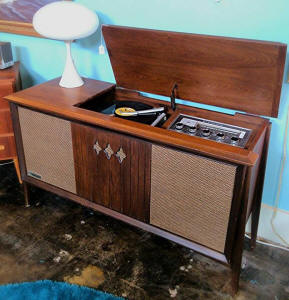 If
you are new to this hobby, are less than 50 years old, or have never studied the
history of recorded sound, WELCOME! This is the first step in
understanding what "Victrolas" and antique phonographs are all about. Even if you aren't interested in
collecting phonographs, and simply want to unload an old Victor or Victrola that you found
in Uncle Fred's basement, this page will get you started, and will help you
understand the use (and limitations) of
this website, and will provide introductory information about antique phonographs in general.
If
you are new to this hobby, are less than 50 years old, or have never studied the
history of recorded sound, WELCOME! This is the first step in
understanding what "Victrolas" and antique phonographs are all about. Even if you aren't interested in
collecting phonographs, and simply want to unload an old Victor or Victrola that you found
in Uncle Fred's basement, this page will get you started, and will help you
understand the use (and limitations) of
this website, and will provide introductory information about antique phonographs in general.
The term "Victrola" has confusing
connotations. To someone who is 25 years old and finds an old radio/phonograph console (like the one
on the left) or a portable record player in their parents' basement, they may find the words
"RCA Victor" or "Victrola" inscribed on it. They may assume that they have a
rare antique phonograph that has some real collector value. It's fully
understandable, as these old machines appear as ancient as the pyramids to
someone who was born in the 1990's. That's the difficult part of this
explanation. Most common radio/phono consoles that you come across in basements
or yard sales (such as the one shown here) date from the 1950's or 1960's, and have nothing to
do with this hobby or this website. The RCA Corporation bought Victor in 1929,
and continued to use "Victrola"
as a marketing catch-word on some of their products up until the late 1970's;
but those machines are not true "Victrolas" in the antique-phonograph sense.
In fact, the copyrighted brand name "Victrola" is still in legal use
today by a manufacturer of
portable record players.
First and foremost, most
antique phonograph collectors are primarily interested in the machines and
recordings made between 1880 and 1930.
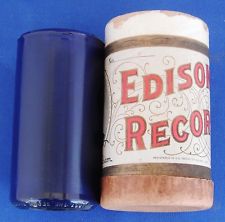 The
cylinder record (right) was the original invention of Thomas Edison in 1877, and
pre-dates the flat record (below right) by almost 15 years. The history and
technology of cylinder records goes way beyond the scope of this website, but
plenty of good reading material is available online. Edison marketed and sold
his phonograph cylinders and players for many years. Since Edison's designs and
concepts were strongly protected by patents, and his cylinders were relatively
expensive to produce in large volumes, a competitive and improved design was
developed. The
flat disc record was designed and manufactured by Emile Berliner
beginning in 1892. Unlike the cylinder, the flat record
could be
inexpensively duplicated by pressing them from a master disc, similar
to a printing press, and it offered the advantage of having music available on
both sides. Most disc records were made from a shellac-based compound, which
became brittle after pressing, but provided acceptable durability given
reasonable care. Quality wasn't the greatest in early years, but over time,
the lower cost, ease of storage and continually improving performance made the Berliner
disc the dominant audio reproduction medium.
Many entrepreneurs jumped onto the phonograph manufacturing bandwagon in the
early 1900's, with every company making a slightly different product trying to avoid patent infringement
issues with each other. Legal
battles between phonograph companies were ongoing for many years, as each design feature was challenged and
defended by competitors, all vying to sell more phonographs. Hundreds of phonograph companies popped-up
on the business horizon in the early years, including brands such as Columbia,
Regal, Sonora, Silvertone and many others. The Victor Talking
Machine Company of Camden, New Jersey (who later made the "Victrola") was just
one of those early competing companies. It was founded in 1901 by machinist and
inventor Eldridge Johnson, who had been one of Berliner's early business
partners. Through aggressive and savvy management, Victor eventually became the dominant
force in the phonograph marketplace, relying on the 78 RPM Berliner record
design as the basis for their products. As a result of the legal skirmishes, Mr.
Berliner moved his operations to Montreal Canada, and sold machines under the
brand "The Berliner Gramophone Company".
The
cylinder record (right) was the original invention of Thomas Edison in 1877, and
pre-dates the flat record (below right) by almost 15 years. The history and
technology of cylinder records goes way beyond the scope of this website, but
plenty of good reading material is available online. Edison marketed and sold
his phonograph cylinders and players for many years. Since Edison's designs and
concepts were strongly protected by patents, and his cylinders were relatively
expensive to produce in large volumes, a competitive and improved design was
developed. The
flat disc record was designed and manufactured by Emile Berliner
beginning in 1892. Unlike the cylinder, the flat record
could be
inexpensively duplicated by pressing them from a master disc, similar
to a printing press, and it offered the advantage of having music available on
both sides. Most disc records were made from a shellac-based compound, which
became brittle after pressing, but provided acceptable durability given
reasonable care. Quality wasn't the greatest in early years, but over time,
the lower cost, ease of storage and continually improving performance made the Berliner
disc the dominant audio reproduction medium.
Many entrepreneurs jumped onto the phonograph manufacturing bandwagon in the
early 1900's, with every company making a slightly different product trying to avoid patent infringement
issues with each other. Legal
battles between phonograph companies were ongoing for many years, as each design feature was challenged and
defended by competitors, all vying to sell more phonographs. Hundreds of phonograph companies popped-up
on the business horizon in the early years, including brands such as Columbia,
Regal, Sonora, Silvertone and many others. The Victor Talking
Machine Company of Camden, New Jersey (who later made the "Victrola") was just
one of those early competing companies. It was founded in 1901 by machinist and
inventor Eldridge Johnson, who had been one of Berliner's early business
partners. Through aggressive and savvy management, Victor eventually became the dominant
force in the phonograph marketplace, relying on the 78 RPM Berliner record
design as the basis for their products. As a result of the legal skirmishes, Mr.
Berliner moved his operations to Montreal Canada, and sold machines under the
brand "The Berliner Gramophone Company".
Victor produced a huge variety
of large and small phonographs with external horns, some with internal horns
hidden behind "tone doors" on the front, portables,
electrically-powered versions and a host of others (a few examples shown below).
At first, these phonographs were considered to be novelties; simple crude
machines, with rather poor sound quality. Within a few years, a number of
advancements were made to enhance the sound quality and convenience of talking machines.
By the mid-1920's, with the advent of advanced technology and electronics
(much of it developed during World War One), both phonographs and recordings
improved significantly. To improve fidelity, the use of brittle shellac material
used in records was
phased-out, being replaced by plastic compounds that were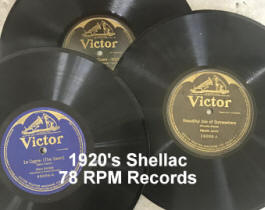 easier to press and resulted in less surface noise. In turn, phonograph tonearms
became much lighter to reduce record wear.
easier to press and resulted in less surface noise. In turn, phonograph tonearms
became much lighter to reduce record wear.
In 1929, The Radio Corporation of America
(RCA) bought Victor, along with its entire product line and factories, and the
company became "RCA Victor". That is the point in history where the information
on this website stops, as it denotes the end of "early phonograph industry".
However, the
basic
78 RPM Berliner record format remained
prominent through the 1940's, using the improved plastic-based material. By the mid-1950's, the long-playing 33-1/3 RPM
vinyl "LP" record and the compact 45 RPM discs came to dominate the industry;
by 1958, the 78RPM record was obsolete.
These recording systems are not compatible
with one another. If you attempt to play a vinyl LP
or a 45 RPM record on an early wind-up Victrola, not only will the heavy arm and needle
crush the grooves, the motor is not designed to play the much-slower format of
the newer records. Take a look on EBay! Many of the Victrolas shown for sale
have vinyl LP records sitting on the turntable. They may look okay, but they sure
won't play. Even if you play a 1940's 78 RPM record on an early Victrola, it will
sound distorted, and the record will wear out very quickly. Those
later-vintage 78's weren't designed for the heavy tonearm used on early phonographs. Many people come to this site via Google or Yahoo looking for information on
an RCA 1950's phonograph they have come across at a yard or estate
sale. You won't find it here. In addition, you aren't going to find any information
on this website if you wish to learn
about an early Edison wind-up machine, a 1949 Philco phonograph, a TV/phono console, or your parents'
1960's Mantovani records. Don't get us wrong. There are many collectors interested in
these items; but that isn't our purpose. We only cover machines made by "The
Victor Talking Machine Company" from 1900-1929.
Much more on this topic in the GETTING STARTED pages (follow link below).
It should be noted again that "Victrola" brand portable phonographs are
still being produced today. These electronic machines are designed for
modern home entertainment and cater to those who wish to play newer vinyl LP's.
These machines are not covered on this website.
Millions of Victor and Victrola branded phonographs (with both internal and external horns) were made from 1901 through the late 1920's, so even today, most of these old phonographs are not considered "rare" in the context of having high value, as there are simply too many of them still around. Of course, there are some low-production models that can be quite valuable, depending on demand and condition. You can find out more about your Victor machine by reading through these pages.
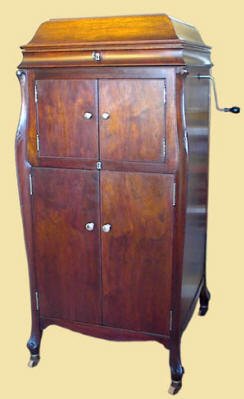
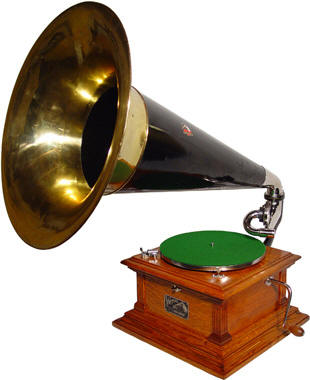
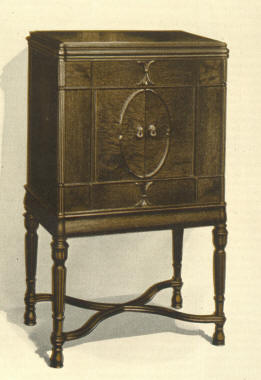
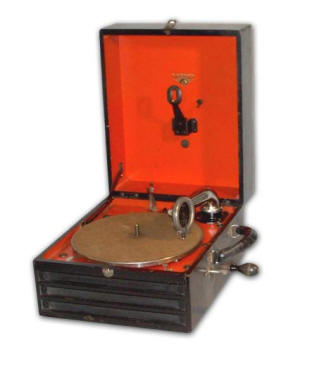
So here are the "Top Ten" misunderstood issues we come across on this site:
"Victor" or "Victrola" does not mean any old phonograph. Just like "Chevrolet" does not mean any old car. These names were associated with a specific brand of products, initially owned and marketed by The Victor Talking Machine Company, and later by RCA. This website is devoted to pre-1929 Victor Talking Machine products only.
There were hundreds of different brands of phonographs made from the late 1800's up until the 1980's. Victor & Victrola is only one of those brands, and is the only brand covered on this website
The terms "vinyl", LP", "High Fidelity", "microgroove", and "stereo" come from records and phonographs made from the late 1940's onward, and are not covered by this website.
If your phonograph has a TV, an AM/FM radio, or a multi-speed changer, this website won't be of any help. It isn't considered to be an "antique phonograph", although it may be well over 60 years old.
You can't play anything but 78 RPM records on a Victor or Victrola; to be safe, they should be pre-1935 shellac recordings to avoid premature wear (picture below)
You can't adapt your Victor or Victrola to play anything but 78 RPM records.
Most Victrolas are not "highly valuable", even though they may be over 100 years old. They made many millions of them for over 25 years, and hundreds of thousands are still around. There are rare and valuable models, to be sure, but they are few and far between.
Most 78 RPM records have a nominal value from 50 cents to $2.00, if they are in good shape. They made many hundreds of millions of them, and they still show-up by the boatload. It's hard to sell them unless you are willing to do a lot of legwork finding buyers, and you won't become rich. There are some rare ones out there, but they are not likely to turn-up with the 1940's Frank Sinatra and Glenn Miller albums in your dad's basement. Sorry for the bad news.
We have lots of information here about Victor Phonographs and Victrolas, and this site can answer most of your questions if you are willing to take the time to do some reading. With over 140 emails coming in daily, we can't answer all questions, especially if the information is already covered on this site.
We don't sell parts or provide restoration services. We are also not experts on the details of motor repair. That information can be found on our RESOURCES page.
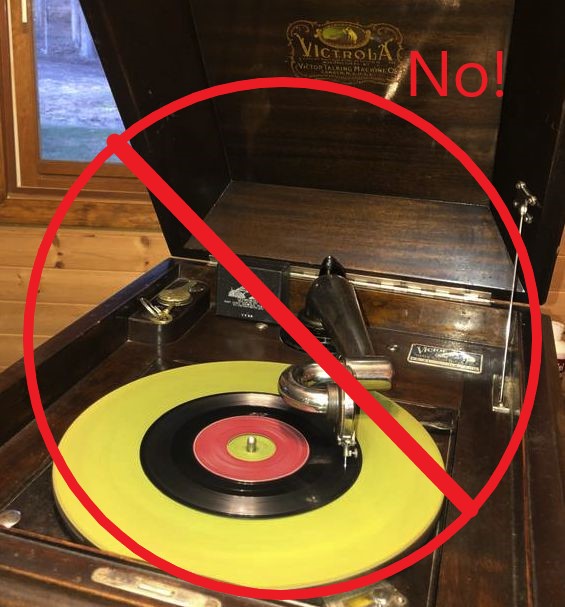
Helpful Tip of the Day: Don't play 33 or 45 RPM records on your Victrola. The heavy needle will destroy the record grooves, and the machine is not designed to operate at those slower turntable speeds. These machines are only designed for use with shellac records operating between 76 and 80 RPM.
Please return to the "GETTING STARTED" pages to guide you through the process of learning about your Victor Phonograph!
Thanks for visiting!
Rev 2 7-18-2020